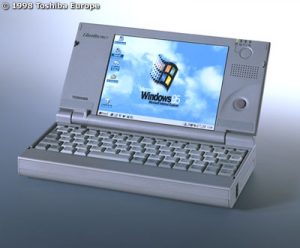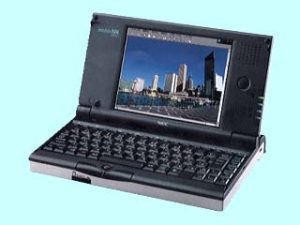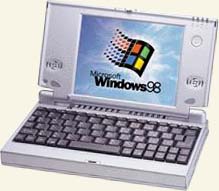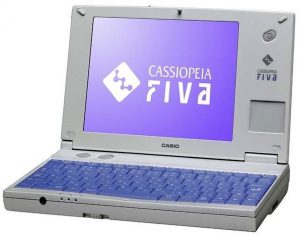Is that a notebook in your pocket or are you just glad to see me? No – actually none of the “Mininote” fits into a normal pocket. “Mininote” (Which means “mini notebook”) is a term that was used in Japan and somehow never made it to other countries. Wikipedia calls them “Subnotebook” even though this term is also used for bigger notebooks. But as with all terms we use they are stretchable anyways. Typical palmtop computers of the early 1990s like the Poqet PC or Sharp PC-3000 typically fit neither on your palm or in your pocket (The HP 200LX somehow did – if you had considerably large pockets). The IBM Palmtop PC 110 kinda really fitted on a palm, but due to it’s thickness also typically didn’t fit in a pocket. The IBM PC110 was kinda unfair competition in late 1995 since IBM Japan spent as much money developing and manufacturing it that they made a big loss even though one unit costed something like a good used car – but oh well it was a prestige thing they could afford. Exact figures are unknown, but rumours say that the PC110 would have been profitable if it costed more than a brand new small car. Anyways, IBM had proven their point and had no intention to produce more than their original first batch.
So a few months later – April 1996 to be precise – Toshiba Japan came up with a new design that actually made sense from an economic point of view – the Libretto 20. It was considerably bigger (like 2 of the mentioned Sharp PC-3000 stacked), memory was the same (8MB standard, 20 MB max), but at least a faster 486 and the TFT screen had more colors.

So even as it was considerably bigger than the IBM PC110 – it was AVAILABLE and that meant a lot. The IBM PC110 would stay the smallest laptop ever for more than a decade, but hey – you could go into a store and buy the Libretto. That made it instantly the smallest laptop you can buy – and at under 200,000 yen for an 8MB model with a 260MB hdd , 75 MHz 486 and brand new Windows 95 it was “expensive” but still cheaper and more practical than the PC110. And a half year later Toshiba released an upgraded 100MHz model. There was always a demand for really tiny laptops in Japan (ride a subway in Tokyo during the rush hour to see why) but now Toshiba really delivered. The “Mininote” craze was born.
In January 1997 Toshiba released the Libretto 50 – now with a Pentium 75, 810MB HDD, 16MB RAM standard and a maximum of 32 MB RAM. An international release came in middle of 1997 and to Toshibas surprise there was also a (small) demand for such tiny machines in the rest of the world. Librettos were Toshibas license to print money, so another CPU upgrade was due in November. But then a challenger appears!

NEC announced it’s “Mobio NX” series in october 1997 – to be released in November 1997. Actually it was released 3 days after the Libretto 70. Although NEC managed to boost the max memory to a whooping 80 MB it came with 16Mb standard (like the libretto 70), the same Pentium MMX 120MHz and a considerably weaker DSTN display (A special TFT version was available for much more money and often not even available in stores) while the Libretto 70 had the new fancy TFT by default. So after all is said the NEC was regarded a poor knockoff of the Libretto. Size-wise the depth was even a bit more than the libretto but it was a bit thinner. it did not sell as well as NEC expected but at least it was not a complete failure. The “OnNow” resume (hibernation) feature was praised as it was pretty fast, but that alone didn’t save the sales figures.
In March 1998 Toshiba released the Libretto 100 – making it a bit bigger by increasing the depth. it now featured a Pentium MMX 166, 2.1 GB HDD and 64MB RAM max. Competition was tiny (Hello NEC!) so it sold quite well. And then suddenly another challenger appears.

The Palmax PD1000 was kinda game changer. Released in July 1998 it featured the rather slow Cyrix Media GX 120MHz – an unimpressive clone of the pentium 120 MMX – but it came with a USB port, 1.6GB HDD and – behold – a touch screen. All that would not have impressed people much, but the price was significantly lower than the competitors. So finally there was a budget Mininote. While Palmax was and is no brand that rings a bell they did have an interesting history. The company behind Palmax was actually the notorious “Tidalwave” corporation from Taiwan who sold their cheap DOS palmtops to loads of more or less famous computer retailers and manufacturers all over the world who would in turn flood the market with countless OEM versions of the Tidalwave PS-1000. Since most retailers and manufacturers who sold their PS-1000 actually already went bankrupt they had to find new partners, so this model was also sold by IPC, Topline, Bestpal, Gericom, forefront and others. The most hyped feature of it was also the biggest drawback: The touch screen. While this was a pretty cool feature in 1998 it was also clear that Windows 98 was not really optimized for touch screens and most DOS games and appz were also not really much fun with a touchscreen.
NEC and Toshiba kept on releasing upgraded versions that only got you a better processor and more RAM while suddenly another challenger appears.

The Casio Fiva came out pretty late, but it tried to fix some of the shortcomings of the competition. While most people from outside of Japan only know Casio for cheap digital wristwatches they actually made a pretty fine “Mininote” in Japan. When released in November 1998 the Fiva did not only sport a USB bus but also the brightest display and that in a whooping 800 x 600 resolution while all other mininotes still had 640 x 480. The processor was “Not that impressive” being a Cyrix MMX 200MHz, but max RAM was already 96MB and it was the first mininote to feature a real touchpad compared to the mouse stick of the competition. With HDD options between 3.2 and 6.4 GB it was also a challenger on the disk space side of life.
All four of these manufacturers released other updated models of their Mininotes, but Casio remained the winner of the 1990s spec run selling a considerable number of Fivas in Japan and later even in the U.S.
I could continue with the 2000s but i guess i keep that for another blog post.